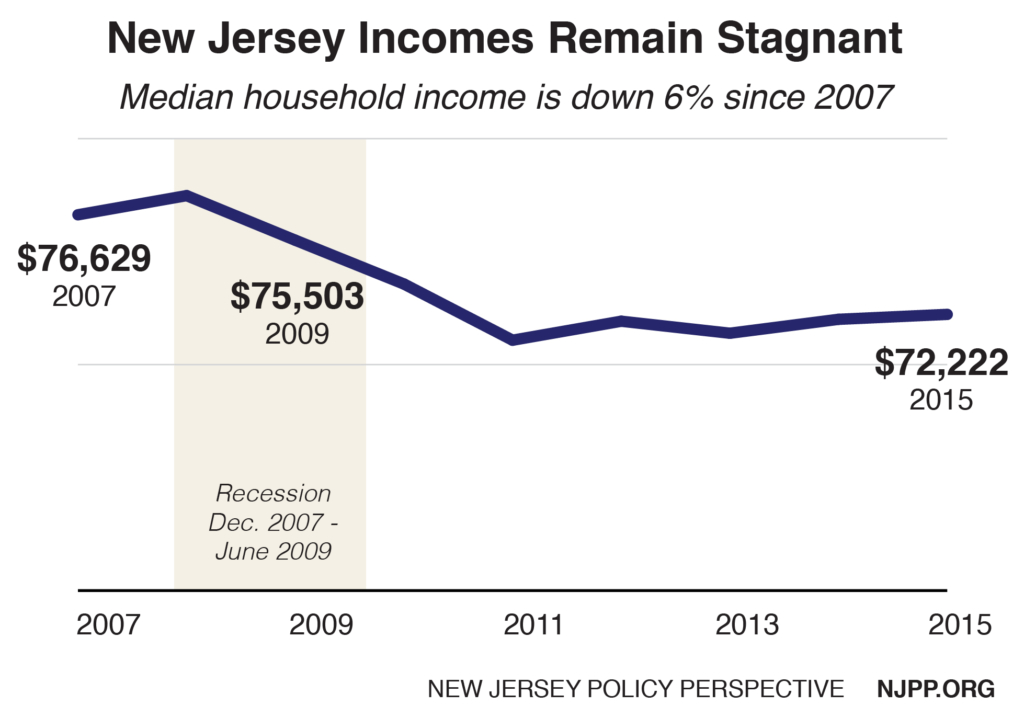It is no secret that New Jersey is one of the nation’s most expensive states. In fact, only the District of Columbia, Hawaii and New York cost more to cover essential needs like housing, food and transportation. If $100 is the national average of what’s required to meet those needs, the number in New Jersey is $114.50, according to research by the federal Bureau of Economic Analysis. Since a dollar doesn’t stretch as far here in the Garden State as it does nearly everywhere else, it is all the more important for our lawmakers to enact policies that help raise household incomes and increase the amount of money in the pockets of New Jersey residents. Unfortunately, the vast majority of New Jerseyans have seen their pockets steadily lose money for nearly a decade.
Median household income in New Jersey dropped to $72,222 in 2015 from $76,629 in 2007, after adjusting for inflation and the increased cost of basic daily needs, goods and services.
Enter the ALICE Report, which details the alarming financial reality that many New Jersey families experience. ALICE – which stands for Asset Limited, Income Constrained, Employed – looks at the economic difficulties that residents throughout the state are dealing with and focuses on residents who, as the name describes, are working but have low incomes and limited assets.
According to the updated ALICE report released last November, of the 3.2 million households in New Jersey, 341,000 – about 11 percent – are in poverty, as defined by the Federal Poverty Level of $11,670 for a single adult and $23,850 for a family of four.
But this standard federal definition of poverty doesn’t work when it comes to New Jersey’s poor families. Because of the state’s higher costs, hundreds of thousands of New Jersey Jerseyans with incomes above the federal level are still living in real poverty.
In fact, another 824,000 – an additional 26 percent – qualify as ALICE households, meaning they’re working but not making enough to meet the basic cost of living in the state. In all, more than 1 in 3 – or 37 percent of – New Jersey households are unable to afford basic necessities.
 The annual cost for basic necessities for a New Jersey family of four is over $64,000, or two full-time workers each making $16 per hour, according to the ALICE Report. For a single adult, it’s nearly $25,000 – or an hourly wage of $12 for a full-time worker. On average, these costs have increased by 23 percent in the last seven years while wages stayed flat.
The annual cost for basic necessities for a New Jersey family of four is over $64,000, or two full-time workers each making $16 per hour, according to the ALICE Report. For a single adult, it’s nearly $25,000 – or an hourly wage of $12 for a full-time worker. On average, these costs have increased by 23 percent in the last seven years while wages stayed flat.
With median income at just $72,222 and the cost of basic necessities for a family of four at $64,000, families have hardly anything left to deal with costly emergencies or build up modest savings. As inflation continues to rise and household income remains stagnant, the gap between the cost of necessities and earnings will continue to shrink, with more and more families struggling to make it in New Jersey. If trends remain the same and nothing is done soon, the cost of basic necessities could overcome median income in the years ahead.
For too long Trenton’s answer to this problem has been to reduce taxes for the wealthy and corporations, expecting the prosperity to trickle down to the rest of us. But that hasn’t worked. It never has.
To boost hard-working families and improve the state’s economy, lawmakers need to implement pro-worker policies and tax credits such as raising the minimum wage to a living wage, requiring paid sick leave for all workers, supporting and expanding the earned income tax credit. These policies have stood the test of time with plenty of research showing that they help create a stronger, more productive, more resilient economy.


